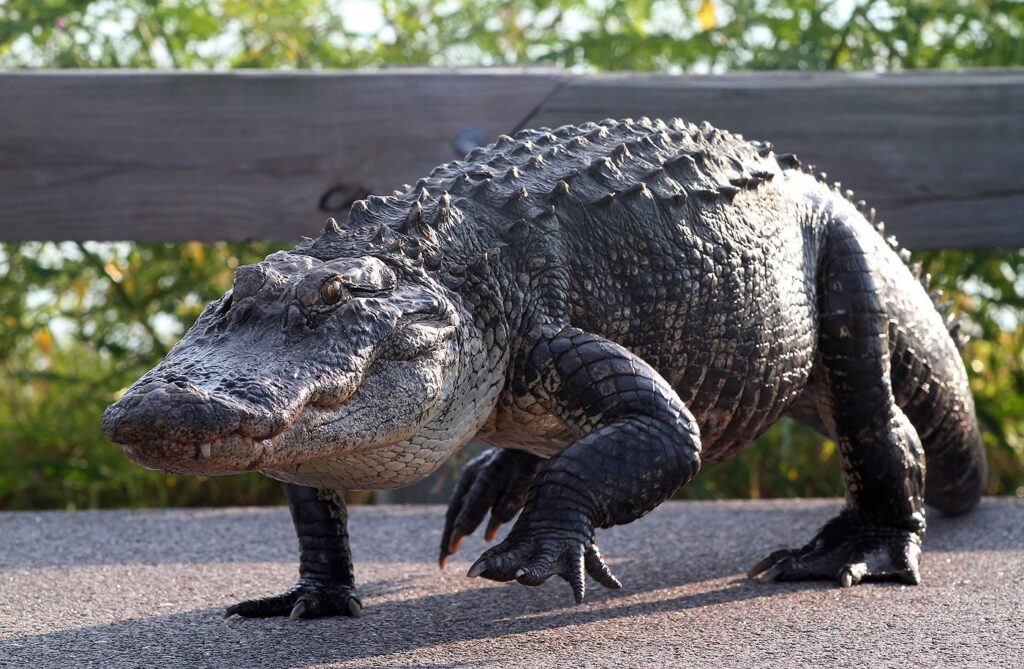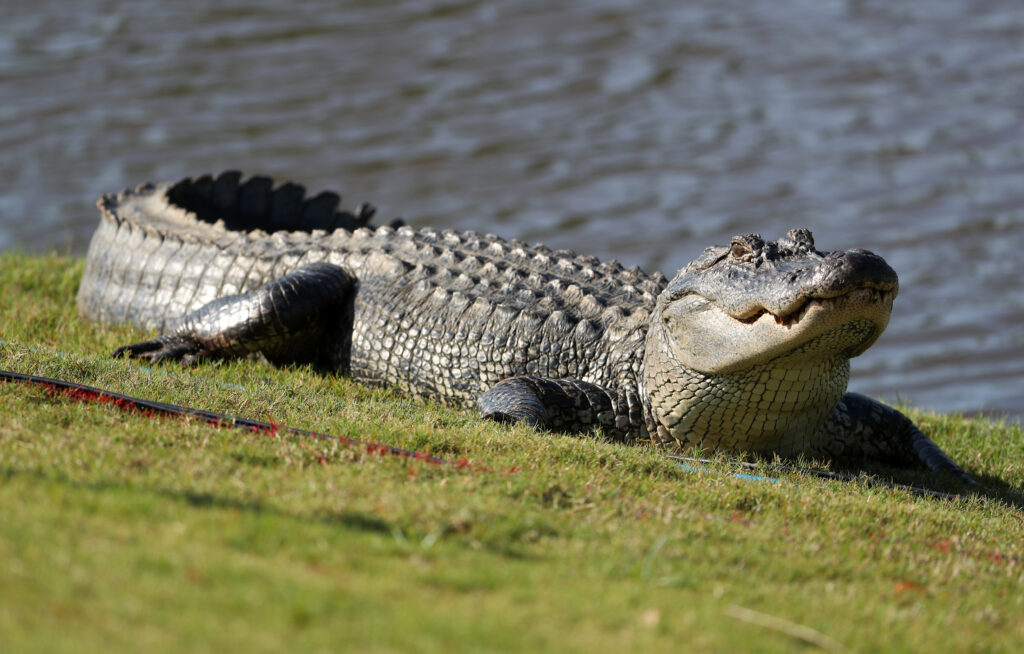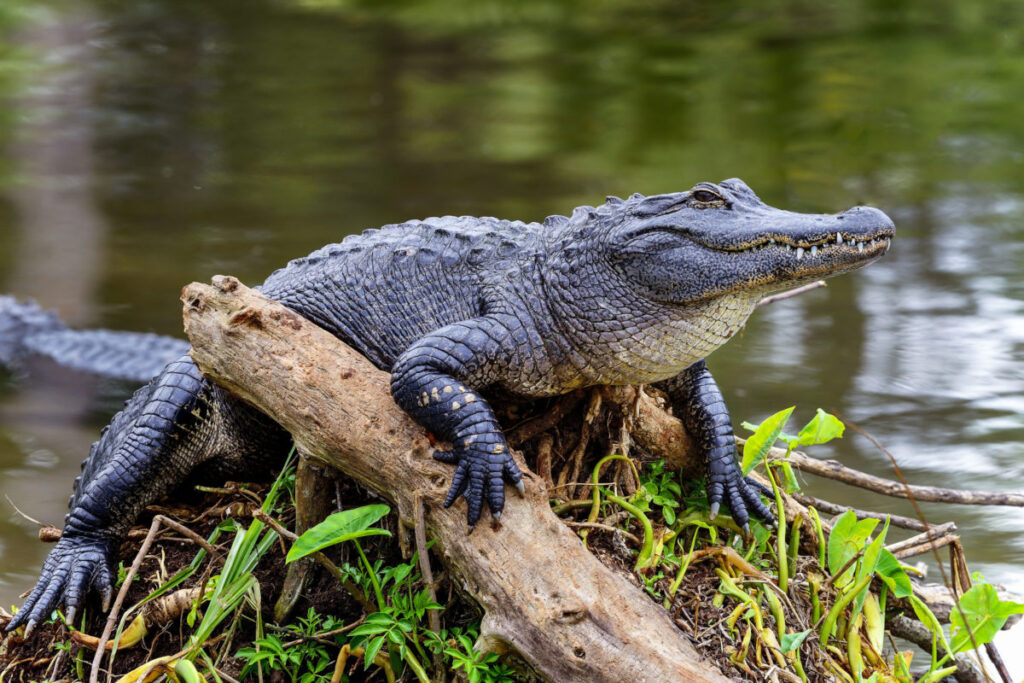Table of Contents
ToggleIntroduction
The alligator, an iconic reptile known for its ancient lineage and distinct appearance, is a creature that has captured human fascination for centuries. Belonging to the order Crocodylia and the family Alligatoridae, alligators are aquatic reptiles with a presence spanning millions of years. These creatures embody a harmonious blend of strength, stealth, and adaptability, making them formidable inhabitants of the world’s wetlands and waterways.
Physical Characteristics Of The Alligator

Alligators are remarkable reptiles renowned for their distinct physical traits, which have evolved over millions of years to help them thrive in their aquatic habitats. From their size and growth patterns to their intricate body structure and unique skin adaptations, these features contribute to their survival and prominence in the animal kingdom.
Size and Growth
Sexual Dimorphism: Sexual dimorphism is evident in alligators, with males and females exhibiting differences in size. Adult male alligators tend to be larger than females. This size difference is particularly pronounced in some species, reflecting specific roles in reproduction and competition.
Growth Patterns and Life Stages: Alligators undergo a fascinating growth journey. They hatch from eggs as relatively small individuals and continue to grow over several decades. Food supply, climate, and environment all play a role in determining growth rates. Alligators experience distinct life stages, from hatchlings to juveniles, subadults, and mature adults.
Body Structure
Head Shape and Features: Alligators are recognizable by their broad, U-shaped snouts. This snout shape is well-suited for capturing prey, allowing them to exert powerful bite force when hunting. Their eyes and nostrils are positioned on the top of their heads, enabling them to remain mostly submerged while observing their surroundings.
Limbs and Locomotion: The sturdy bodies of alligators are well suited for both land and water travel. Their legs are positioned directly beneath their bodies, allowing them to walk on land relatively easily. In water, their limbs are instrumental in steering and maintaining stability during swimming.
Tail and Swimming Adaptations: The tail of an alligator is a crucial tool for aquatic locomotion. It is muscular and has a powerful propeller, allowing the alligator to move efficiently through the water. Their tails also aid in quick bursts of speed, beneficial during hunting and evading predators.
Skin and Armor
Scaly Skin Composition: Alligators possess scaly skin that provides protection and insulation. These scales comprise keratin, the same material in human hair and nails. The scales overlap like tiles, offering flexibility while retaining a certain rigidity.
Osteoderms and Protection: Embedded within their skin are osteoderms, bony plates that provide an additional layer of defense. These osteoderms offer protection against potential threats, including the bites of other predators. The arrangement of osteoderms varies across the body, with thicker clusters protecting vital areas.
Camouflage and Coloration: The coloration of alligators’ skin helps them blend into their surroundings, enhancing their ability to ambush prey and evade predators. Typically, their skin features a dark coloration, ranging from brownish-black to olive green, which aids in camouflage amidst the murky waters of their habitats.
The intricate physical characteristics of alligators serve as a testament to their evolutionary adaptations and role as apex predators in their ecosystems. From their versatile limbs to their powerful tails, alligators are finely tuned for survival, contributing to their status as awe-inspiring symbols of the natural world.
Behavior And Ecology Of The Alligator
With their intriguing behaviors and ecological roles, alligators offer a window into the complex interactions that shape their lives and the ecosystems they inhabit. From their carnivorous feeding habits to their pivotal role as keystone species, alligators contribute significantly to the balance and diversity of wetland habitats.
Feeding Habits
Carnivorous Diet: Alligators are carnivores, primarily feeding on a diet that includes fish, amphibians, birds, mammals, and invertebrates. Their diet varies based on habitat availability and seasonal changes in prey populations.
Hunting Techniques: Alligators employ various hunting techniques depending on their prey. They are adept ambush predators, lying motionless in the water and waiting for unsuspecting prey to approach. With their keen senses, they detect vibrations in the water caused by movement, allowing them to strike swiftly with their powerful jaws.
Reproduction and Nesting
Mating Behaviors: Alligator mating behaviors are often territorial and involve vocalizations, head-slapping on water surfaces, and visual displays. Males emit deep bellows and roars to establish dominance and attract females during the breeding season.
Nest Construction and Location: Female alligators build nests using plant material and mud, often in secluded areas near water bodies. These nests provide warmth and protection for their eggs. The ideal nesting location strikes a balance between thermal comfort and security.
Egg Laying and Incubation: After constructing nests, female alligators lay eggs. The mother then guards the nest and regulates the temperature by adding or removing nesting material. The nest’s temperature determines the sex of the hatchlings, highlighting the significance of thermal regulation in their development.
Social Interactions
Solitary vs. Social Behaviors: Alligators display solitary and social behaviors. While they tend to be alone in their hunting and territorial activities, they sometimes tolerate each other’s presence, especially in areas with abundant food resources.
Communication Methods: Alligators communicate through vocalizations, body language, and visual displays. Vocalizations include bellows, roars, and hisses, which play roles in attracting mates, defending territory, and establishing dominance. Body language, such as head-slapping and posturing, further communicates their intentions.
Role in the Ecosystem
Keystone Species in Wetland Habitats: Alligators play a critical role as keystone species in their ecosystems. Their presence influences the populations of prey species and helps maintain the balance of the food chain. By controlling the numbers of certain prey, alligators indirectly contribute to the health and diversity of wetland habitats.
Impact on Prey and Competitor Populations: Alligators’ predation impacts the populations of their prey, preventing the overpopulation of certain species and promoting biodiversity. Additionally, their presence can influence the behavior and distribution of other predators, such as smaller reptiles and birds.
Conservation And Threats To Alligators

With their ancient lineage and ecological importance, alligators face various conservation challenges that have shaped their historical decline and current status. From the historical pressures of hunting to the modern threats posed by habitat loss and climate change, understanding these challenges is vital for ensuring the continued survival of these remarkable reptiles.
Historical Perspective
Alligator Hunting and Population Decline: Historically, alligators faced severe population declines due to intensive hunting for their valuable hides and meat. This relentless exploitation led to sharp reductions in their numbers and distribution across their native habitats.
Legal Protections and Recovery Efforts: To keep the alligator population stable, legislation prohibiting reptile sales or taking has been enacted. These efforts and conservation initiatives helped mitigate the population decline and support the recovery of alligator populations in some regions.
Current Conservation Status
Endangered Status of Chinese Alligators: The Chinese alligator (A. sinensis) is in imminent danger of extinction by the International Union for Conservation of Nature (IUCN). This species faces severe threats due to the destruction of its habitats, the introduction of harmful pollutants, and the species’ limited geographic range in China.
Stable Population of American Alligators: The American alligator has experienced a relatively successful recovery in recent decades. Due to conservation efforts, including habitat protection and regulated hunting, their populations have rebounded, leading to their removal from the U.S. Fish and Wildlife Service’s endangered species list.
Threats To Alligators
Habitat Loss and Degradation: Urbanization and land development have led to the destruction and fragmentation of wetland habitats, crucial for alligator survival. Loss of these habitats directly impacts their ability to find suitable nesting sites, hunt, and regulate their body temperature.
Human-Wildlife Conflicts: As human populations expand, conflicts between alligators and people can arise. Encounters near residential areas, recreational spaces, and water bodies can lead to safety concerns, sometimes resulting in the removal of alligators or changes in their behavior.
Climate Change and Sea Level Rise: Rising temperatures and sea levels can alter the habitat suitability for alligators. Changes in nesting conditions, water availability, and temperature regulation may impact their survival and reproduction. Sea level rise can also lead to saltwater intrusion into freshwater habitats.
Poaching and Illegal Trade: Despite legal protections, alligators face threats from poaching and illegal trade in their skins and body parts. Such undermines conservation efforts and perpetuates unlawful activities that can harm alligator populations.
Conclusion
In the murky waters of wetlands and swamps, the alligator symbolizes resilience, adaptability, and the intricate connections between life forms and their environments. From their early evolutionary origins to their vital roles as apex predators, these reptilian giants have captured our imagination and underscored the importance of conservation in a rapidly changing world.







